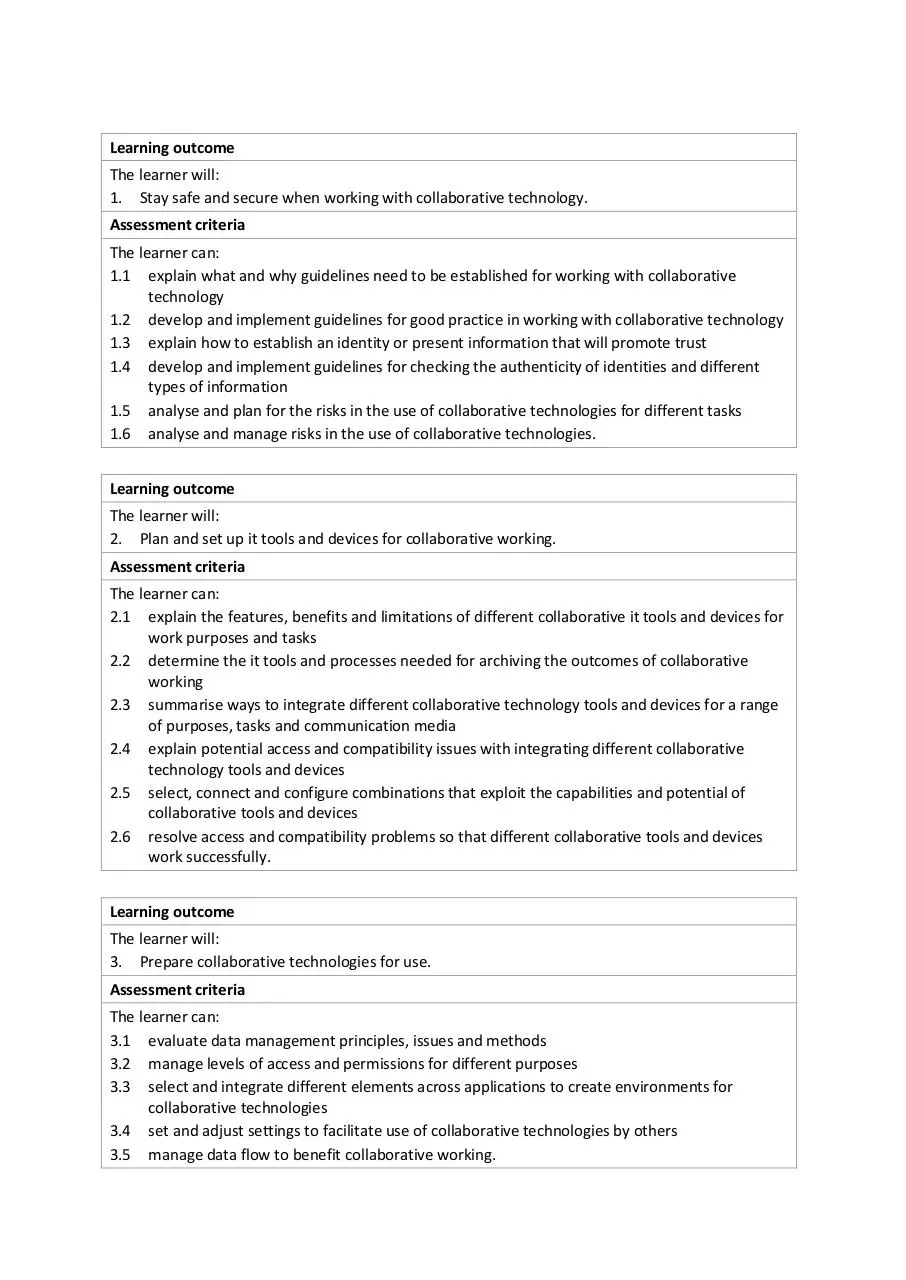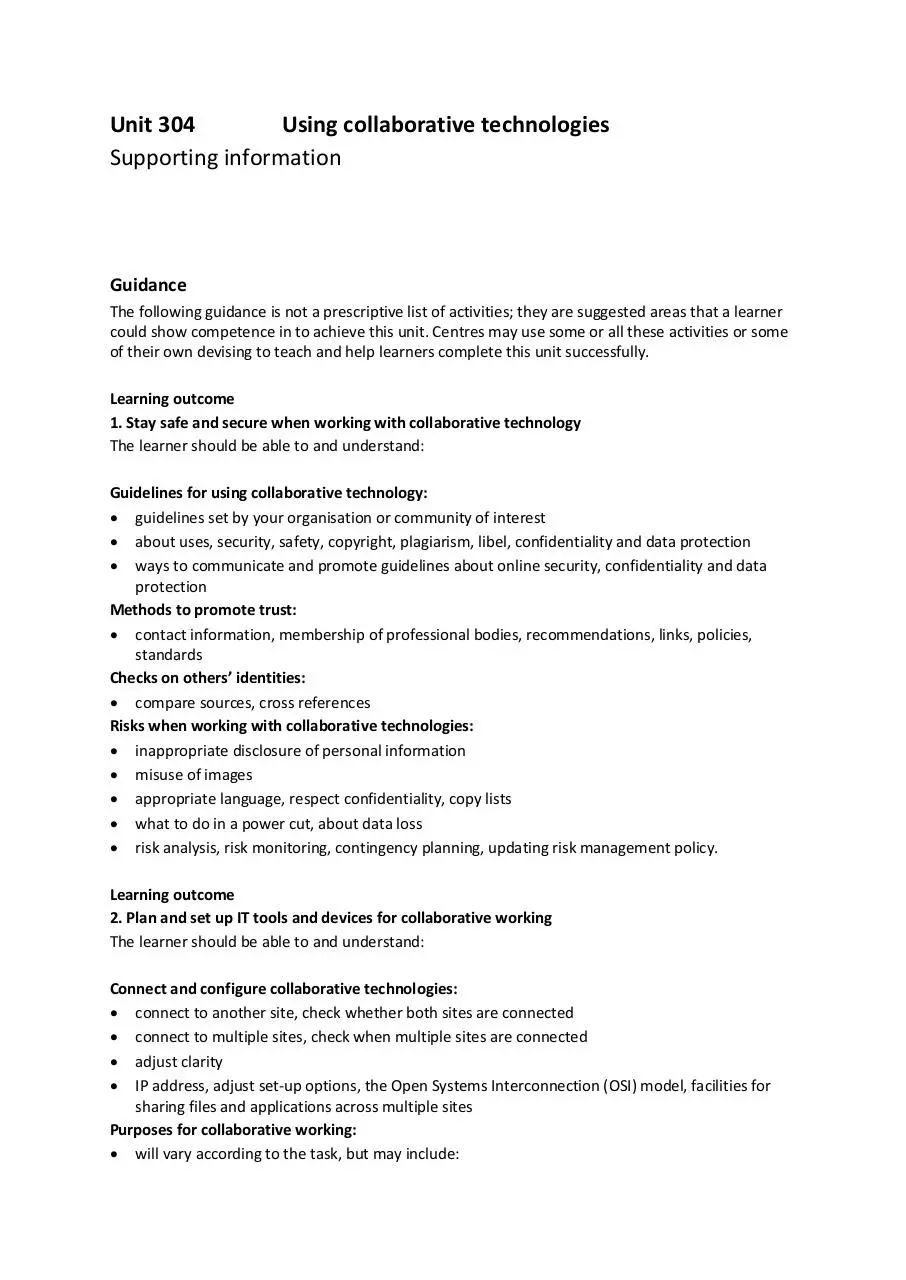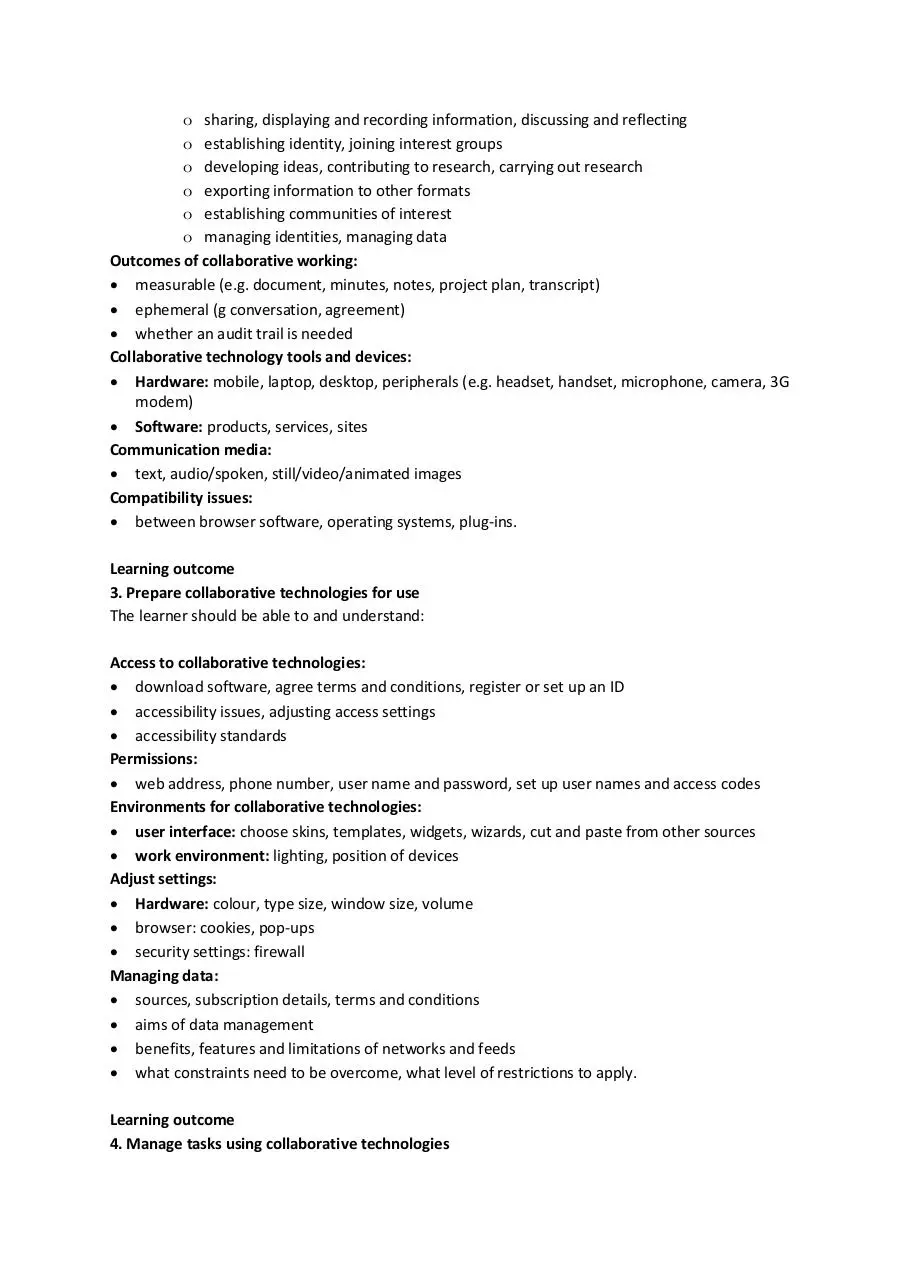Specification (PDF)
File information
Author: Michael Lafferty
This PDF 1.5 document has been generated by Microsoft® Word 2010, and has been sent on pdf-archive.com on 21/04/2017 at 18:33, from IP address 89.16.x.x.
The current document download page has been viewed 631 times.
File size: 244.29 KB (6 pages).
Privacy: public file





File preview
Unit 304
Using collaborative technologies
UAN:
T/502/4380
Level:
3
Credit value:
6
GLH:
45
Relationship to NOS:
This unit is linked to the Level 3 National Occupational
Standards for IT users devised by e-Skills UK (Sector Skills
Council for ICT).
Endorsement by a sector or
regulatory body:
This unit is endorsed by e-Skills UK, the Sector Skills Council
for ICT.
Aim:
This unit is about the ability to use IT tools and devices for
collaborative working and communications, such as web or
video conferencing, instant messaging/chat, online phone
and video calls; online forums, social networking sites, wikis
and other centralised depositories for documents, blogging,
RSS and data feeds, bulk SMS or online work management
tools.
On completion of this unit a candidate should be able to
manage and effectively integrate and facilitate the safe use
of multiple IT tools and devices so that groups can work
collaboratively and effectively by:
setting and implementing guidelines for using
collaborative technologies;
integrating IT tools and devices and creating
environments to exploit their potential;
managing risks, permissions and data flow; and
moderating and solving complex problems with the use
of collaborative technologies;
Examples of context: Typical collaborative activities may
include – developing guidelines and instructions for a work
team about the use of social networking; moderating online
conference sessions or web discussion groups for a
professional community of interest.
Learning outcome
The learner will:
1. Stay safe and secure when working with collaborative technology.
Assessment criteria
The learner can:
1.1 explain what and why guidelines need to be established for working with collaborative
technology
1.2 develop and implement guidelines for good practice in working with collaborative technology
1.3 explain how to establish an identity or present information that will promote trust
1.4 develop and implement guidelines for checking the authenticity of identities and different
types of information
1.5 analyse and plan for the risks in the use of collaborative technologies for different tasks
1.6 analyse and manage risks in the use of collaborative technologies.
Learning outcome
The learner will:
2. Plan and set up it tools and devices for collaborative working.
Assessment criteria
The learner can:
2.1 explain the features, benefits and limitations of different collaborative it tools and devices for
work purposes and tasks
2.2 determine the it tools and processes needed for archiving the outcomes of collaborative
working
2.3 summarise ways to integrate different collaborative technology tools and devices for a range
of purposes, tasks and communication media
2.4 explain potential access and compatibility issues with integrating different collaborative
technology tools and devices
2.5 select, connect and configure combinations that exploit the capabilities and potential of
collaborative tools and devices
2.6 resolve access and compatibility problems so that different collaborative tools and devices
work successfully.
Learning outcome
The learner will:
3. Prepare collaborative technologies for use.
Assessment criteria
The learner can:
3.1 evaluate data management principles, issues and methods
3.2 manage levels of access and permissions for different purposes
3.3 select and integrate different elements across applications to create environments for
collaborative technologies
3.4 set and adjust settings to facilitate use of collaborative technologies by others
3.5 manage data flow to benefit collaborative working.
Learning outcome
The learner will:
4. Manage tasks using collaborative technologies.
Assessment criteria
The learner can:
4.1 determine levels of responsibility for the use of collaborative technologies
4.2 facilitate others' responsible contributions to and engagement with collaborative
technologies
4.3 manage the moderation of collaborative technologies
4.4 oversee the archiving of the outcomes of collaborative working
4.5 explain what problems can occur with collaborative technologies
4.6 respond to problems with collaborative technologies and be prepared to help others to do so.
Unit 304
Using collaborative technologies
Supporting information
Guidance
The following guidance is not a prescriptive list of activities; they are suggested areas that a learner
could show competence in to achieve this unit. Centres may use some or all these activities or some
of their own devising to teach and help learners complete this unit successfully.
Learning outcome
1. Stay safe and secure when working with collaborative technology
The learner should be able to and understand:
Guidelines for using collaborative technology:
guidelines set by your organisation or community of interest
about uses, security, safety, copyright, plagiarism, libel, confidentiality and data protection
ways to communicate and promote guidelines about online security, confidentiality and data
protection
Methods to promote trust:
contact information, membership of professional bodies, recommendations, links, policies,
standards
Checks on others’ identities:
compare sources, cross references
Risks when working with collaborative technologies:
inappropriate disclosure of personal information
misuse of images
appropriate language, respect confidentiality, copy lists
what to do in a power cut, about data loss
risk analysis, risk monitoring, contingency planning, updating risk management policy.
Learning outcome
2. Plan and set up IT tools and devices for collaborative working
The learner should be able to and understand:
Connect and configure collaborative technologies:
connect to another site, check whether both sites are connected
connect to multiple sites, check when multiple sites are connected
adjust clarity
IP address, adjust set-up options, the Open Systems Interconnection (OSI) model, facilities for
sharing files and applications across multiple sites
Purposes for collaborative working:
will vary according to the task, but may include:
o
o
o
o
o
o
sharing, displaying and recording information, discussing and reflecting
establishing identity, joining interest groups
developing ideas, contributing to research, carrying out research
exporting information to other formats
establishing communities of interest
managing identities, managing data
Outcomes of collaborative working:
measurable (e.g. document, minutes, notes, project plan, transcript)
ephemeral (g conversation, agreement)
whether an audit trail is needed
Collaborative technology tools and devices:
Hardware: mobile, laptop, desktop, peripherals (e.g. headset, handset, microphone, camera, 3G
modem)
Software: products, services, sites
Communication media:
text, audio/spoken, still/video/animated images
Compatibility issues:
between browser software, operating systems, plug-ins.
Learning outcome
3. Prepare collaborative technologies for use
The learner should be able to and understand:
Access to collaborative technologies:
download software, agree terms and conditions, register or set up an ID
accessibility issues, adjusting access settings
accessibility standards
Permissions:
web address, phone number, user name and password, set up user names and access codes
Environments for collaborative technologies:
user interface: choose skins, templates, widgets, wizards, cut and paste from other sources
work environment: lighting, position of devices
Adjust settings:
Hardware: colour, type size, window size, volume
browser: cookies, pop-ups
security settings: firewall
Managing data:
sources, subscription details, terms and conditions
aims of data management
benefits, features and limitations of networks and feeds
what constraints need to be overcome, what level of restrictions to apply.
Learning outcome
4. Manage tasks using collaborative technologies
The learner should be able to and understand:
Contributing responsibly:
follow the rules of ‘netiquette’, respect others contributions, avoid dominating and not
responding
legal and cultural issues
user rules, moderations policies, ethical issues
Moderating collaborative technologies:
reporting inappropriate content
checking posts
Archiving outcomes:
cut, paste, save; record, transcribe
Problems with collaborative technologies:
routine (e.g. settings, software not responding, hardware connections)
non-routine (e.g. access, transmission speed, bandwidth); complex (e.g. compatibility)
Respond to problems:
follow on screen help, know who to ask for expert help
use diagnostic wizards, check bandwidth.
Download Specification
Specification.pdf (PDF, 244.29 KB)
Download PDF
Share this file on social networks
Link to this page
Permanent link
Use the permanent link to the download page to share your document on Facebook, Twitter, LinkedIn, or directly with a contact by e-Mail, Messenger, Whatsapp, Line..
Short link
Use the short link to share your document on Twitter or by text message (SMS)
HTML Code
Copy the following HTML code to share your document on a Website or Blog
QR Code to this page

This file has been shared publicly by a user of PDF Archive.
Document ID: 0000587177.